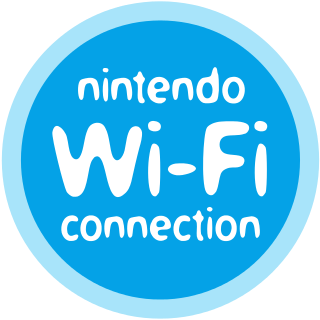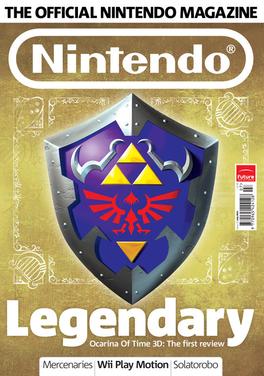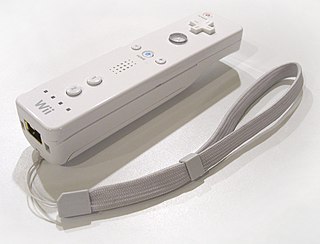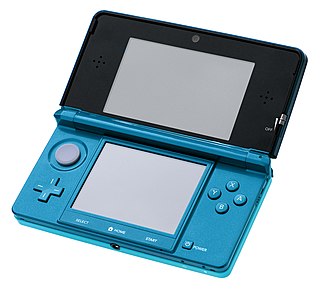
The Wii is a home video game console developed and marketed by Nintendo. It was released on November 19, 2006, in North America, and in December 2006 for most other regions of the world. It is Nintendo's fifth major home game console, following the GameCube and is a seventh-generation console alongside Microsoft's Xbox 360 and Sony's PlayStation 3.
Homebrew, when applied to video games, refers to software produced by hobbyists for proprietary video game consoles which are not intended to be user-programmable. The official documentation is often only available to licensed developers, and these systems may use storage formats that make distribution difficult, such as ROM cartridges or encrypted CD-ROMs. Many consoles have hardware restrictions to prevent unauthorized development.

Nintendo Wi-Fi Connection was an online multiplayer gaming service run by Nintendo that formerly provided free online play in compatible Nintendo DS and Wii games. The service included the company's Wii Shop Channel and DSi Shop game download services. It also ran features for the Wii and Nintendo DS systems.

Official Nintendo Magazine, or ONM, was a British video game magazine that ran from 2006 to 2014 that covered the Nintendo DS, Nintendo 3DS, Wii, and Wii U video game consoles released by Nintendo.

WiiConnect24 is a discontinued feature of Nintendo Wi-Fi Connection for the Wii. It was first announced at Electronic Entertainment Expo (E3) in mid-2006 by Nintendo. It enabled the user to remain connected to the Internet while the console was on standby. For example, in Animal Crossing: City Folk, a friend could send messages to another player without the recipient being present in the game at the same time as the sender.

The Wii Remote, informally referred to with the portmanteau Wiimote, is the primary game controller for Nintendo's Wii home video game console. An essential capability of the Wii Remote is its motion sensing capability, which allows the user to interact with and manipulate items on screen via motion sensing, gesture recognition, and pointing using an accelerometer and optical sensor technology. It is expandable by adding attachments. The attachment bundled with the Wii console is the Nunchuk, which complements the Wii Remote by providing functions similar to those in gamepad controllers. Some other attachments include the Classic Controller, Wii Zapper, and the Wii Wheel, which was originally released with the racing game, Mario Kart Wii.

The Wii Shop Channel is a discontinued digital distribution service for the Wii video game console. The service allowed users to purchase and play additional software for the Wii, including exclusive games, and games from prior generations of video games. The Wii Shop Channel launched on November 19, 2006, and ceased operations on January 30, 2019.

A Mii is a customizable avatar used on several Nintendo video game consoles and mobile apps. The name Mii is a portmanteau of "Wii" and "me", referring to them typically being avatars of the players. Miis were first introduced on the Wii console in 2006 and later appeared on the DS, 3DS, the Wii U, the Switch, and various apps for smart devices such as Miitomo. Miis can be created using different body, facial and clothing features, and can then be used as characters within games on the consoles, either as an avatar of a specific player or in some games portrayed as characters with their own personalities. Miis can be shared and transferred between consoles, either manually or automatically with other users over the internet and local wireless communications.

The Wii system software is a discontinued set of updatable firmware versions and a software frontend on the Wii home video game console. Updates, which could be downloaded over the Internet or read from a game disc, allowed Nintendo to add additional features and software, as well as to patch security vulnerabilities used by users to load homebrew software. When a new update became available, Nintendo sent a message to the Wii Message Board of Internet-connected systems notifying them of the available update.

The Japanese multinational consumer electronics company Nintendo has developed seven home video game consoles and multiple portable consoles for use with external media, as well as dedicated consoles and other hardware for their consoles. As of September 30, 2021, in addition to Nintendo Switch, Nintendo has sold over 863.07 million hardware units.

The Nintendo DSi is a dual-screen handheld game console released by Nintendo. The console launched in Japan on November 1, 2008, and worldwide beginning in April 2009. It is the third iteration of the Nintendo DS, and its primary market rival was Sony's PlayStation Portable (PSP). The fourth iteration, entitled Nintendo DSi XL, is a larger model that launched in Japan on November 21, 2009, and worldwide beginning in March 2010. Development of the DSi began in late 2006, and the handheld was unveiled during an October 2008 Nintendo conference in Tokyo. Consumer demand convinced Nintendo to produce a slimmer handheld with larger screens than the DS Lite. Consequently, Nintendo removed the Game Boy Advance (GBA) cartridge slot to improve portability without sacrificing durability.

Wii no Ma was a Wii channel that featured a video-on-demand, film rental and shopping service operated by Nintendo and Dentsu. Wii no Ma was released on 1 May 2009, exclusively in Japan, and it could be downloaded from the Wii Shop Channel for free, although paid videos could be purchased with Wii Points. The service was shut down on 30 April 2012.

The Nintendo DSi system software is a discontinued set of updatable firmware versions, and a software frontend on the Nintendo DSi video game console. Updates, which are downloaded via the system's Internet connection, allow Nintendo to add and remove features and software. All updates also include all changes from previous updates.

The Nintendo 3DS is a foldable handheld game console produced by Nintendo. The console was announced in March 2010 and unveiled at E3 2010 as the successor to the Nintendo DS. The system features backward compatibility with Nintendo DS video games. As an eighth-generation console, its primary competitor was Sony's PlayStation Vita.

The Nintendo 3DS system software is an updatable operating system used for the Nintendo 3DS handheld system. The Nintendo Switch system software is believed to have evolved from the Nintendo 3DS operating system.

The Nintendo eShop is a digital distribution service for the Nintendo Switch, and formerly available via the Nintendo Network for the Wii U and Nintendo 3DS. The Nintendo eShop was first launched in June 2011 on the Nintendo 3DS via a system update that added the functionality to the HOME Menu. It is the successor to both the Wii Shop Channel and DSi Shop. Unlike on the Nintendo 3DS, the eShop was made available on the launch date of the Wii U, although a system update is required in order to access it. It is also a multitasking application, which means it is easily accessible even when a game is already running in the background through the system software, though this feature is exclusive to the Wii U and the Nintendo Switch. The Nintendo eShop features downloadable games, demos, applications, streaming videos, consumer rating feedback, and other information on upcoming game releases.
The Nintendo Network was an online service formerly ran by Nintendo that provided free online functionality for the Nintendo 3DS and Wii U systems and their compatible games. Announced on January 26, 2012, at an investors' conference, it was Nintendo's second online service after Nintendo Wi-Fi Connection. Former president of Nintendo Satoru Iwata said, "Unlike Nintendo Wi-Fi Connection, which has been focused upon specific functionalities and concepts, we are aiming to establish a platform where various services available through the network for our consumers shall be connected via Nintendo Network service so that the company can make comprehensive proposals to consumers."

The Wii U operating system also known internally as Cafe OS is the official firmware version and system software for the Nintendo's Wii U home video game console. Nintendo maintains the Wii U's systemwide features and applications by offering system software updates via the Internet. Updates are optional to each console owner, but may be required in order to retain interoperability with Nintendo's online services. Each update is cumulative, including all changes from previous updates.
SpotPass and StreetPass were communication systems first introduced in the Nintendo 3DS; SpotPass was later incorporated into the Wii U game console. SpotPass delivered content from the Internet to the consoles, while StreetPass uses local Wi-Fi functionality to exchange data between 3DS systems.















